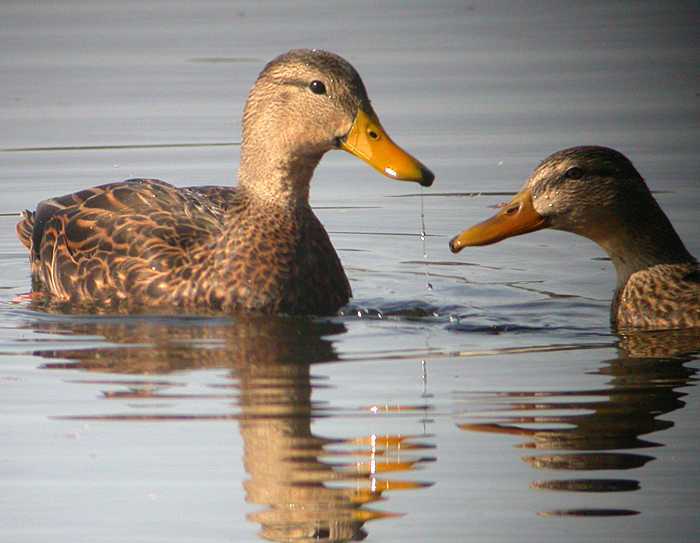
Mottled duck, orMottled mallard(Anas fulvigula)
Phylum —chordata
Class — aves
Order — anseriformes
Family — anatidae
Genus –anas
Appearance
The adult mottled duck is 44 to 61 cm (17–24 in) long from head to tail. It has a dark body, lighter head and neck, orange legs and dark eyes. Both sexes have a shiny green-blue speculum (wing patch), which is not bordered with white as with the mallard. Males and females are similar, but the male's bill is bright yellow, whereas the female's is deep to pale orange, occasionally lined with black splotches around the edges and near the base.
Habitat
Mottled ducks are found only in North America and are year-round residents. They are found in high densities in the intermediate marshlands of Louisiana and Southern Texas. Their population is very dense in the state of Florida from Alachua County to Cape Sable. However, they are found in the highest numbers in the wetlands around Lake Okeechobee and the areas around the Upper St. Johns River. They are also found in small numbers around the Gulf of Mexico, Alabama and the Mississippi coastal borders.
Behavior
Mottled ducks have the ability to walk well on land (waddling) and are strong swimmers. They have strong, deep wing beats which result in direct and slow flight. In general, males are more aggressive than females, except when females have young.
Mottled ducks have many behaviors to show aggression or fear, including: bill threats (the bird raises its beak to ward off predators and intruders), chasing, biting, inciting (when an unpaired female turns her head toward males to gain their attention), gesture-of-repulsion (a female holds her head close to her body and remains in a crouched position to ward off potential and unwanted mates), extra-pair copulation flights (a male tries to overtake/overpower a female that is not his usual mate) and pursuit flights (two males try to overtake one female in order to mate).
Diet
Mottled ducks are carnivores and herbivores. They eat aquatic invertebrates and small fish. They often eat snails, crayfish, beetles, dragonfly nymphs, fish and midge larvae. Invertebrates make up from 1 to 40 percent of their diet. They also eat seeds, grasses, aquatic vegetation and rice.
Mottled ducks usually feed in pairs in the fall and winter. During the summer, they may feed in small groups of about twenty. From August through October (especially in the rice fields) they often feed in flocks of around three thousand.
Reproduction
Mottled ducks breed once yearly. Eighty percent have formed pairs by November and mating begins in January. Pairs usually break-up shortly after the eggs are laid and incubation begins. The ducks are monogamous during the breeding season. They are not monogamous for life, however. Each season new pairs are formed.
The nests are made of matted grass and are on the ground or suspended over shallow water and are in dense grasses. Females lay 5 to 13 eggs per clutch. The eggs take 24 to 28 days to hatch. The ducks fledge after 45 to 56 days. After the eggs hatch, the females lead the brood from the nest. The ducklings are precocial and are able to find their own food. They tend to eat invertebrate larvae when available. The females give alarm calls if an intruder approaches the nest or her young. Broods tend to gather together at night to keep safe. The females usually stay with the ducklings until they can fly.They are independent adults in 65 to 70 days. Both males and females are sexually mature in one year.
Mottled ducks have relatively short lifespans, on average they live for only 2 years. The longest known lifespan in the wild is thirteen years. The expected lifespan in the wild is five years. The expected lifespan in captivity is twenty years.
In captivity
In summer, mottled ducks are kept in outdoor enclosures. The minimum size of the enclosure is 3 square meters.
In winter, mottled ducks should be transferred to an insulated enclosure with a temperature of at least +15°C.It is desirable to equip the enclosure with additives in the form of branches and perches.In the winter room, you must install a pool with running or frequently replaced water.
As a winter bedding for waterfowl, you can use soft hay, which is laid out in places where birds rest.
The diet includes grain feed-corn, wheat, barley, millet, oatmeal, wheat bran, grass, meat and fish meal, chalk, small shell, gammarus. In the warm season, it is good to give various greens - cut dandelion leaves, lettuce, plantain, duckweed. Good food for ducks - wet mixture of grated carrots, bran, various cereals. During the reproductive period and during molting, they are mixed with wet food or given separately: fish and minced meat. During working out a diet it should be calculated that the amount of raw protein does not exceed 16%.
Mottled ducks are friendly to other birds, so they can be kept in the same pond with other ducks.
Artificial shelters for nests are installed in the paddock. Ducks independently incubate, breed and raise ducklings.
 Russian
Russian
 English
English
























